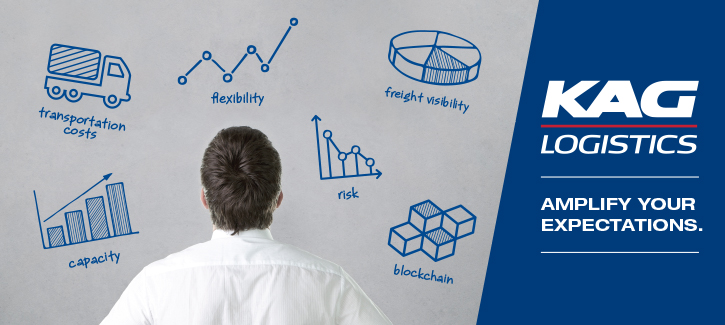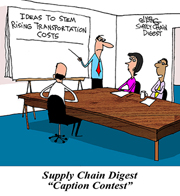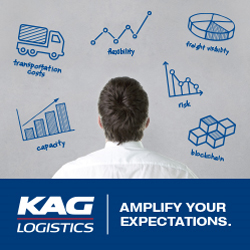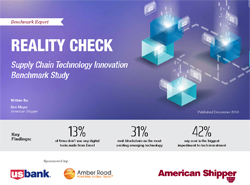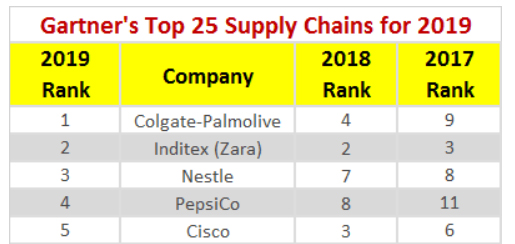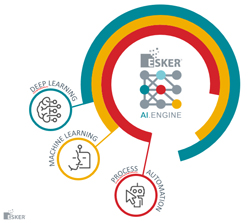 |
SUPPLY CHAIN NEWS BITES
|
US Truckload Rates Finally Slowing Down
|
|
 |
Tariffs on Chinese Imports May Accelerate US Store Closings
|
 |
Will China Reduce Rare Earth Metal Exports to US |
 |
Shoe Companies Says Tariffs will Hit Consumers Hard |
 |
Major Retailers at Risk from Higher Costs
|
| |
|
|
|
|
|
|
|
Understanding the Gartner Top 25 Supply Chains 2019
What are the best supply chains in the world?
The reality is there is no way to determine that, absent an incredibly detailed study of leading candidates that would even then lead to potentially dubious results and certainly be obsolete by the time the research was finished. Or, we could look at the Gartner top 25 supply chain list.
I spent a couple of days at the Gartner Supply Chain Executive Conference a week ago in Phoenix (See Trip Report: Gartner 2019 Executive Conference) where the top 25 list is now unveiled each year at a "gala" dinner.
| GILMORE SAYS: |
My advice: if you are really serious about this, arrange "briefings" with Gartner analysts touting what you are doing in supply chain in the same way that software vendors do.
WHAT DO YOU SAY?
Send us your
Feedback here
|
The former AMR Research brilliantly came up with the top 25 idea in 2004. Gartner then acquired AMR in 2010. Over the last few years, the concept has been extended, so that we now have a "Next 25," plus the top 25 healthcare, industrial, and consumer goods supply chains, etc.
So once again at the conference this year, I asked around a bit, and found - not surprisingly and as usual - that very few supply chain practitioners have any real idea how the list is determined. They only know if they are in or they are out, and that's about all that matters.
This year Colgate-Palmolive came out on top for the first time - sort of.
I put it that way because gain in 2019, Apple, Procter & Gamble, Amazon, McDonald's and now joining them Unilever were left off the formal top 25, as those five companies have been placed in a separate relatively new category called "supply chain masters," a sort of supply chain hall of fame. To get there, Gartner says a company needs to have attained top-five composite scores for at least seven out of the last 10 years.
In fact, it appears these five companies would have been the top five for 2019, meaning Colgate-Palmolive is really rated as sixth best supply chain.
Why does Gartner do this? It frankly may have to do with in effect getting more companies in the top 25 plus the new masters category combined - Gartner clients like that recognition, of course. It may also allow the top 25 list to appear a bit more dynamic.
As I have said before, I find the masters list idea a little goofy, but so be it.
With Amazon, Apple, P&G, McDonald's and Unilever withdrawn from the competition, the rest of the top 10 was (2) Inditex (Zara), (3) Nestle, (4) Pepsico, (5) Cisco, (6) Intel, (7) HP, (8) Johnson & Johnson, (9) Starbucks, and (10) Nike.
Just two new companies made the Supply Chain Top 25 this year versus 2010, that being Chinese ecommerce giant Alibaba and AkzoNobel (a pharma company). With Unilever being promoted to the masters list, just one other company fell out of the top 25 - Kimberly-Clark.
Below is a chart of this year's Top 25, also with where each company placed in the previous two years (NA means not in the top 25 that year). |
|
|
So, you ask, how on earth is the top 25 determined?
Gartner starts with the Fortune 500 list of top US companies by revenue and the Forbes global 2000 list that basically does the same thing on a worldwide basis. It then eliminates a lot of those companies because they do not much operate what most of us would think of as a real physical supply chain - companies in banking, insurance, software, and many more.
What's more, the minimum revenue to be included in the final evaluation list was again an amazing $12 billion.
From that culled list, Gartner analyzes publicly available financial data, specifically looking at three metrics from 2018 financial reports:
Return on assets (ROA): Net income / total assets
Inventory turns: Cost of goods sold / inventory levels
Revenue growth: Change in revenue from prior year
ROA and revenue growth use a three-year weighted average, meaning the most recent year gets the most weight and the two prior years somewhat less. Inventory turns, smartly, uses the prior year's quarterly average (reducing impact of end of year games). These three metrics together are given a full 40% of the total score weight (20% to ROA, 10% to turns, and 10% to revenue growth). Those percentage weightings are actually down 10 percentage points again this year, as I will explain in a moment.
Now keep in mind that this formula gives a tremendous advantage to some companies, such as Amazon given its huge revenue growth or McDonald's and its 175 or so inventory turns per year. It also penalizes companies like a Home Depot or a Lowes, for example, which are only going to have turns in the mid-single digits at best, because of their need to stock every item under the sun to meet customer service targets, many of which are very slow movers.
In general, this approach penalizes a company within a given sector that strategically decides on a higher service, lower turns strategy (even though we can all agree that inventory efficiency is a very important attribute of supply chain excellence). It also gives an advantage to companies that are aggressive acquirers in terms of the revenue growth factor.
Companies that have heavily outsourced production and distribution also have an inherent advantage. Why? Because they have chosen to shed assets, and that often drives their ROA metric higher. While outsourcing can be a very smart thing for many reasons, it does not inherently improve a supply chain. This metric also inherently discriminates against asset-intensive businesses, such as chemicals and automotive. That is in why we see only three such companies (Schneider Electric, BASF and BMW) in the top 25, generally towards the end of the list.
So, at this point, you must be a very large and public company to be considered in the analysis. Private companies do not have the public financial data needed for this part of formula and cannot make the list.
For fourth year now, a new corporate social responsibility factor was added, which now represents 10% of the total composite score. This factor, entered in the end as a number between 1 and 10, comes from a combination of publicly available 3rd party scores on this criteria (which you can trust as accurate or not) and if a company produces a sustainability report. Six of the top eight received a perfect 10 score on this measure, as did a number of other in the top 25. Gartner notes it has tweaked the CSR measurement since its introduction.
Another 25% of the final rankings come from so-called "peer opinion." For 2019, this consisted of about 162 (down from 184 last year) apparently very influential respondents who first select a group of 25 companies from the master list of about 300 that they believe are doing the best job of being a "demand-driven value network orchestrator." Sure, we all have that list in our heads.
From those selections, respondents are then asked to rank those companies from first to last, from which points are assigned to the companies selected based on how they are scored across respondents.
So, the reference point, in theory at least, is not "the best supply chain," but rather leadership in "DDVN orchestration." Are these the same things? I would say certainly not. Gartner defines DDVN orchestration as is being "characterized by an understanding of customer value with processes and metrics that enable business trade-offs to deliver products and services profitably. Companies that work toward the DDVN ideal use demand management as a key differentiating capability, so they can plan, sense and shape in a way that brings profitable balance to the business."
The final 25% of the composite score came from votes from 38 of Gartner's own supply chain analysts. They use the same tool and criteria that the peer group does in ranking company supply chains.
Take the financial rankings, the external CSR scores, and the votes from peer group and Gartner analyst group (again, 40%, 10%, 25%, and 25%, respectively), and voila, out spits the top 25 in something like a mathematical fashion.
Is the process perfect? Certainly not. The unstated assumption is, for example, that stellar financial results equals supply chain excellence. Only very, very large companies are considered. I am not sure demand-driven orchestration should really be the evaluation framework. Who really knows how good most other company supply chains are? And it seems clear to me that working with Gartner and even better speaking at the Executive Conference always has a beneficial effect on a company's placement.
There are other mysteries. For example, pharma company AzkoNobel, which came out of nowhere to number 24 after having never been on the list before, was dead last among the top 25 in analyst ratings, was very low on peer rankings, was a little above average in inventory turns, and had negative three-year revenue growth of -8.6%.
But it had the third highest ROA score of 20.9%, and scored 8 out of 10 on CSR. That all somehow turns into a top 25 best supply chain ranking. Really?
So, with all that, here in general is the advice I give to companies hoping to crack the top 25: (1) understand the methodology, especially with regard to the financial data. Not much you can really do about that, but you can at least understand how it works and do some comparisons to key competitors; (2) encourage others outside your organization to participate in the peer review process and rate you highly; and (3) most important, if you are really serious about this, arrange "briefings" with Gartner analysts touting what you are doing in supply chain in the same way that software vendors do. Ladle on significant helpings of demand-driven orchestration-ness. (Shoot me an email if you would like to discuss any of this.)
And speak at the conference.
The Gartner top 25 supply chains - it has many faults, but it is the best we've got. I look forward to it every year. It certainly stirs the pot - but there must be a better way.
What do you think of the Gartner Top 25 supply chain list and methodology? How could it be done better? Let us know your thought at the Feedback button below.
|
 |
|
|
| |
|
|



![]()

![]()

![]()

![]()
